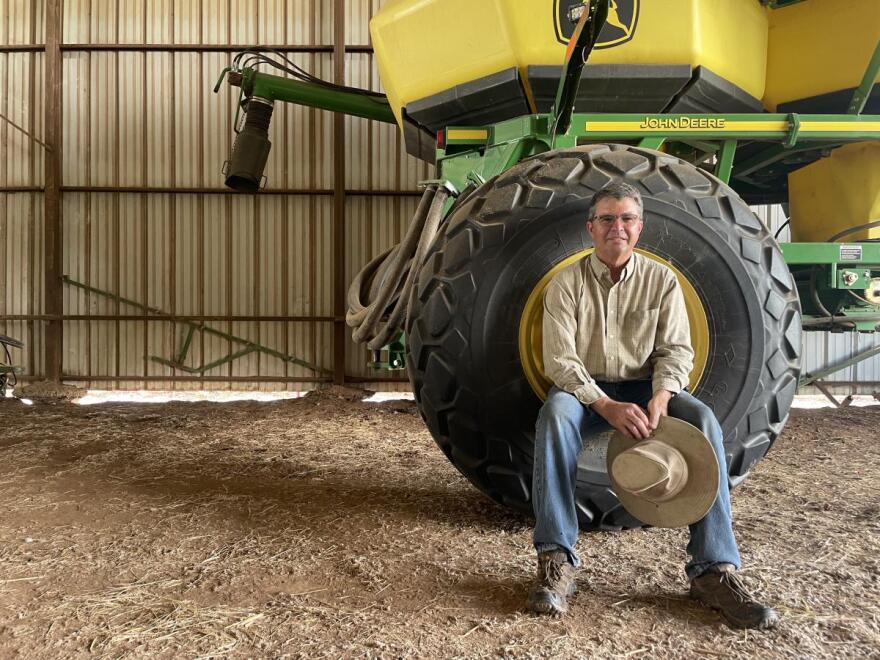Jimmy Emmons has all sorts of things growing in his fields in Leedey, Oklahoma. There’s peas, beans, millets and varieties of grain sorghum, but none of it is for harvest.
He’s growing what’s known as cover crops — plants meant to cover the ground and preserve it. Over the past seven years, he says he’s watched the difference in the soil. He’s often carrying a shovel on his fields, looking and even smelling the dirt.
“Smells real earthy and sweet,” Emmons says.
For years, conservationists and the U.S. Department of Agriculture have urged farmers to plant other crops in between harvests, saying it can prevent erosion and enrich the soil. President Joe Biden even mentioned cover crops in hisfirst address to Congress.But some farmers and scientists say the conservation isn’t worth the water in dry regions like Oklahoma and Kansas.
Farmers planted 50% more cover crops in 2017than in 2012, according to the 2017 Census of Agriculture. More than 2,000 Oklahoma farmers reported using cover crops.Augustine Obour, a soil scientist at Kansas State University, says the practice benefits the soil.
“We've seen that when we take soil measurements, we do soil analysis, we see improvement in soil properties,” Obour says.
Scientists like Obour say cover crops don’t always work economically in dry areas, though. David Nielsen, a retired U.S. Department of Agriculture researcher, says it all comes down to a scientific concept called Liebig’s Law of the Minimum: the availability of the most limited quantity will be what affects growth or yield.
“So you take the water away, the yields are going to go down,” Nielsen says.
Nielsen says cover crops make more sense in states that have higher amounts of rain or for those who irrigate their crops.
John Holman, a professor of agronomy at Kansas State University, has been studying cover crops for about 15 years.
“Having that biomass out there, we do increase precipitation storage efficiency, that's the retention of that rainfall we received for the next crop,” Holman says. “But the crop, no matter what, we’ve seen it still uses water … with the next crop following it, we have less water for that crop than if it were fallow.”
Jimmy Kinder, a wheat farmer in Walters, Oklahoma, says he tried cover crops for five years. It didn’t go well, he says.
“Three of the five years it was actually a negative impact on the crop,” Kinder says.

Kinder isn’t against the conservation practice, but he says it just doesn’t make sense for his system. He says cover crops haven’t gotten a foothold with a lot of wheat farmers.
“It seems to be difficult to get an economic or even a soil health return from planting a summer cover crop in a short period of time,” Kinder says.
Vance Ehmke owns a seed company in Kansas, but he tells farmers not to use cover crops. He’s been watching the research and believes in the data indicating that the crops aren’t worth the water in dry regions.
“It's just a gigantic fraud,” Ehmke says.
Ehmke tries to dissuade farmers in dry areas from planting cover crops because the costs add up fast. He says some seeds can cost $35 an acre.
“Then you got transporting the seed. You got planting. You’ve got termination costs,” Ehmke says. “I mean, you're just digging a deeper and deeper and deeper hole faster and faster and faster.”
Even in dry areas, there are two ways this practice makes economic sense for farmers: grazing and government payments.

“The only way that we've been able to show it cash flow economically, excluding any government payments … is using that as forage crop,” Holman says.
Emmons, who travels the country encouraging other farmers to grow cover crops, says any decrease in yields depends on how you manage the crops.
“In these extreme dry years that we've been in, you can have a little yield loss if you don't manage these covers right, and you plant too much population,” Emmons says. “If you notice in here, we don’t have what some people would call a full stand. There’s a reason for that. We don’t want to use a lot of water, we just want to keep it covered.”
Ultimately, Emmons says the savings from grazing and the benefits to the soil are worth it.
“If I can take $100 to $150 of beef off of (feeding costs), that's pretty good return on my investment, besides the benefits it's doing for the soil,” Emmons says.
Correction: A quote from Jimmy Emmons has been added to clarify how he uses cover crops in dry conditions.







